It looks simple in theory. All you have to do is keep little
blips on a screen from bumping into each other. Now consider that
those blips represent billions of dollars of government assets and
hundreds of lives, all relying on one person's ability to control
air traffic. This is the job of the 332nd Expeditionary Operations
Support Squadron radar air traffic controllers at Balad Air Base,
Iraq, working in one of the busiest combined en route radar
approach, or CERAP, control facilities, where it's not unfamiliar
to see more than 550 aircraft operations in just one day.
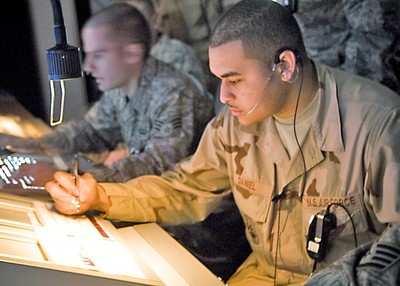
But don't confuse these radar controllers with tower controllers
who manage the airport. "We manage all the arrivals and departures
of aircraft in middle Iraq," said Staff Sgt. Elida Bermudez, a
332nd EOSS air traffic controller and CERAP watch supervisor,
deployed from Travis Air Force Base, Calif.
"It's different working here than anywhere else I've been,"
Sergeant Bermudez said. "The workload -- the airspace -- I'm used
to only heavies, and all it takes is one phone call to take most of
our airspace away, leaving us with only a minimal amount of
airspace to work with." Imagine standing above a beehive looking
down, seeing all the busy bees zooming and zipping back and fourth
in harmony. The same can be said about the airspace around Balad
Air Base and central Iraq, except these bees don't just buzz, they
roar.
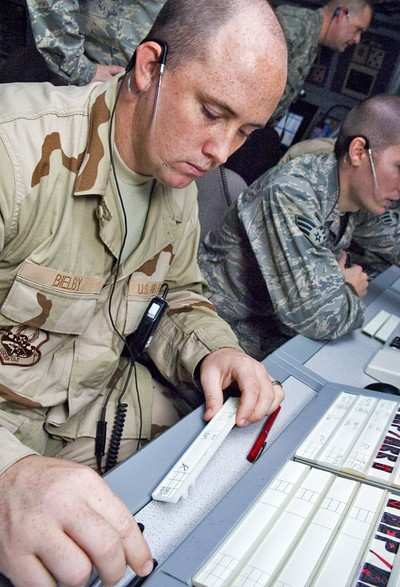
Instead of the aircraft instinctively knowing where to go like
bees, they trust an elite group of more than 30 Airmen to keep them
safely separated from each other, either laterally or by altitude.
Sergeant Bermudez said when it comes to controlling traffic, "I
like it, everyday has something different. But you have to know
what you can and can't handle. You have to know when to say 'uncle'
for the safety of aircraft, and not let your ego get in the way of
a potentially unsafe situation."
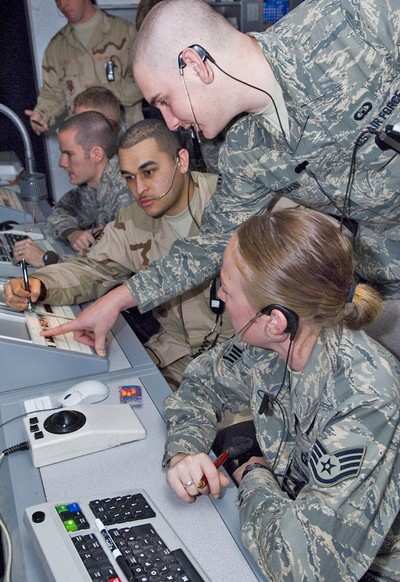
She said the easiest way to overcome those situations is to keep
practicing, and absorb the knowledge from those who are more
experienced. One way of getting the experience is working in all
seven positions in the CERAP: Two approach/departure control
positions with an assist make up the terminal section, and two en
route (or center) control positions with an assist and a flight
data position.
The approach/departure position works directly with aircraft
departing and arriving Balad AB. An approach controller sequences
and separates inbound aircraft as well as getting positive
identification of departing aircraft, while the assist coordinates
aircraft movement with adjacent sectors and fills out flight data
strips.
The CERAP's en route section handles aircraft transiting central
Iraq.
"The CERAP's en route position owns the airspace from 19,000 to
28,000 feet in the air," said Master Sgt. Verlyn Booker, a 332nd
EOSS air traffic controller and CERAP watch supervisor, deployed
from Moody AFB, Ga.
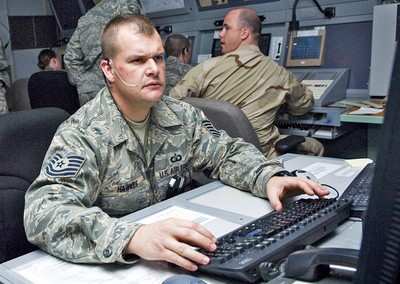
The other position is flight data. The primary role of flght
data is to relay the airspace and traffic in central Iraq between
the CERAP and King Pin, a combat aircraft controlling agency.
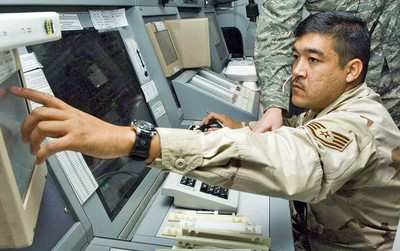
"It's tough work, but if you take care of the Airmen in position
they will take care of you and more importantly, the airspace,"
Sergeant Bermudez said. [ANN Salutes Staff Sgt. Travis Edwards,
332nd Air Expeditionary Wing Public Affairs]
 ANN's Daily Aero-Term (05.19.25): Fuel Remaining
ANN's Daily Aero-Term (05.19.25): Fuel Remaining ANN's Daily Aero-Linx (05.19.25)
ANN's Daily Aero-Linx (05.19.25) Klyde Morris (05.16.25)
Klyde Morris (05.16.25) Airborne 05.19.25: Kolb v Tornados, Philippine Mars, Blackhawk Antler Theft
Airborne 05.19.25: Kolb v Tornados, Philippine Mars, Blackhawk Antler Theft Airborne-Flight Training 05.15.25: Ray Scholarship, Alto NG, Fighter Training
Airborne-Flight Training 05.15.25: Ray Scholarship, Alto NG, Fighter Training







